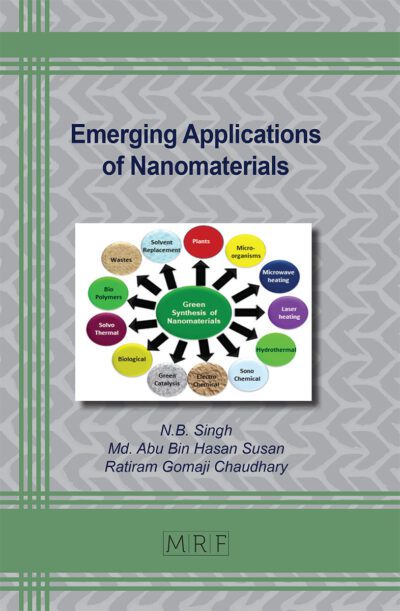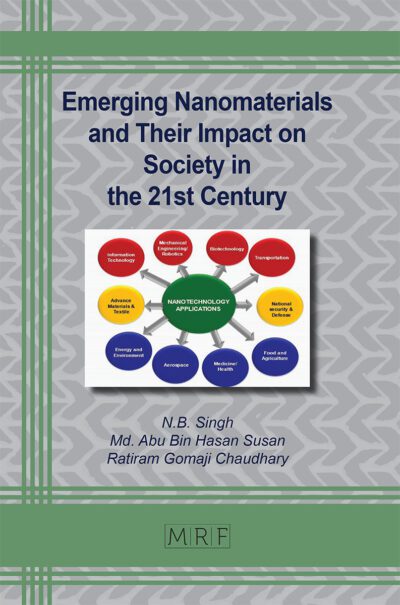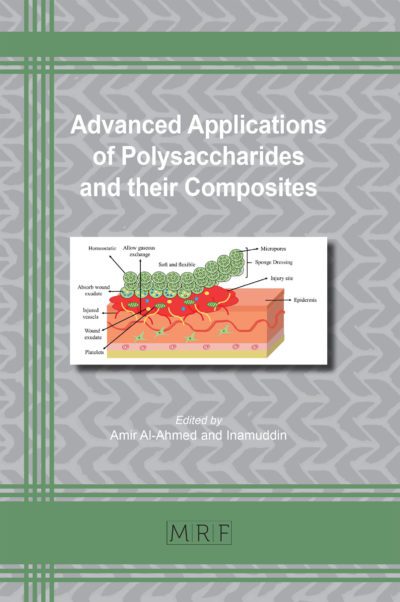A Review on Smart and Eco-Friendly Building Material
T. Jeevetha, S. Vijayashanthy, J. Dharanidharan, B. Bala Murali Krishna
download PDFAbstract. Due to industrialization and man-made activities in and around the world, Day by day pollution levels are drastically increasing. This being said, building materials in the present context can be produced using novel techniques by applying advanced pollution reduction coatings/strategies. The self-cleaning and de-air polluting concept is emphasized in concrete structures using nanotechnology. Photo-catalytic treatment will be a promising approach as it alleviates structural and aesthetic damages on building materials. Finally, the risk exposure due to pollutants can be computed for better treatment of the same.
Keywords
Self-Cleaning, De-Air Polluting Concept, Nanotechnology, Photo-Catalytic Treatment
Published online , 8 pages
Copyright © 2022 by the author(s)
Published under license by Materials Research Forum LLC., Millersville PA, USA
Citation: T. Jeevetha, S. Vijayashanthy, J. Dharanidharan, B. Bala Murali Krishna, A Review on Smart and Eco-Friendly Building Material, Materials Research Proceedings, Vol. 23, pp 106-113, 2022
DOI: https://doi.org/10.21741/9781644901953-14
The article was published as article 14 of the book Sustainable Materials and Smart Practices
![]() Content from this work may be used under the terms of the Creative Commons Attribution 3.0 licence. Any further distribution of this work must maintain attribution to the author(s) and the title of the work, journal citation and DOI.
Content from this work may be used under the terms of the Creative Commons Attribution 3.0 licence. Any further distribution of this work must maintain attribution to the author(s) and the title of the work, journal citation and DOI.
References
[1] A. Khataee, G.A. Mansoori, Nanostructured Titanium Dioxide Materials, World Scientific Publishing Co., Singapore, 2011. https://doi.org/10.1142/8325
[2] E. Keidel, Die Beeinflus sung der lich tech the it von teer far blacken durch titan weiss (Influence of titanium white on the fastness to light of coal-tardays), Farben-Ztg. 34 (1929) Pg: 1242-1243.
[3] C.F. Goodeve, J.A. Kitchener, Photosensitisation by titanium dioxide, Trans. Faraday Soc. 34 (1938) Pg: 570-579. https://doi.org/10.1039/tf9383400570
[4] W. Doerfler, K. Hauffe, Heterogeneous photocatalysis I. The influence of oxidizing and reducing gases on the electrical conductivity of dark and illuminated zinc oxide surfaces, J. Catal. 3 (1964) Pg: 156-170. https://doi.org/10.1016/0021-9517(64)90123-X
[5] A. Fujishima, K. Honda, Electrochemical photolysis of water at a semiconductor electrode, Nature 238 (1972) Pg: 37-38. https://doi.org/10.1038/238037a0
6] R. Wang, K. Hashimoto, A. Fujishima, M. Chikuni, E. Kojima, A. Kitamura, M. Shimohigoshi, T. Watanabe, Light-induced amphiphilic surfaces, Nature 388(1997) Pg: 431-432. https://doi.org/10.1038/41233
[7] M.V. Diamanti, M. Pedeferri, Concrete, mortar and plaster using titanium dioxide nanoparticles: applications in pollution control, self-cleaning and photo sterilization, in Nanotechnol. Eco-Effic. Const, Elsevier, 2013, Pg: 299-326. https://doi.org/10.1533/9780857098832.3.299
[8] A. Fujishima, X. Zhang, D. Tryk, Heterogeneous photocatalysis: from water photolysis to applications in environmental cleanup, Int. J. Hydrogen Energy 32 (2007) Pg: 2664-2672. https://doi.org/10.1016/j.ijhydene.2006.09.009
[9] K. Nakata, A. Fujishima, TiO2 photocatalysis: design and applications, J. Photochem. Photobiol. C Photochem. Rev. 13 (2012) Pg: 169-189. https://doi.org/10.1016/j.jphotochemrev.2012.06.001
[10] A. Folli, C. Pade, T.B. Hansen, T. De Marco, D.E. Macphee, TiO2 photocatalysis in cementitious systems: insights into self-cleaning and de air pollution chemistry, Cem. Concr. Res. 42 (2012) Pg: 539-548. https://doi.org/10.1016/j.cemconres.2011.12.001
[11] L. Graziani, E. Quagliarini, F. Bondioli, M. D’Orazio, Durability of self-cleaning TiO2 coatings on fired clay brick façades: Effects of UV exposure and wet & dry cycles, Build. Environ. 71 (2014) Pg: 193-203. https://doi.org/10.1016/j.buildenv.2013.10.005
[12] M. Baudys, J. Kry’ sa, M. Zlámal, A. Mills, Weathering tests of photocatalytic facade paints containing ZnO and TiO2, Chem. Eng. J. 261 (2015) Pg: 83-87. https://doi.org/10.1016/j.cej.2014.03.112
[13] S. Banerjee, D.D. Dionysiou, S.C. Pillai, Self-cleaning applications of TiO2 by photo-induced hydrophilicity and photocatalysis, Appl. Catal. B Environ. 176-177 (2015) Pg: 396-428. https://doi.org/10.1016/j.apcatb.2015.03.058
[14] M.-Z. Guo, A. Maury-Ramirez, C.S. Poon, Self-cleaning ability of titanium dioxide clear paint coated architectural mortar and its potential in field application, J. Clean. Prod. 112 (Part 4, 2016) Pg: 3583-3588. https://doi.org/10.1016/j.jclepro.2015.10.079
[15] M.M. Hassan, Quantification of the environmental benefits of ultrafine/nano titanium dioxide photocatalyst coatings for concrete pavement using hybrid life-cycle assessment, J. Infrastruct. Syst. 16 (2010) Pg: 160-166. https://doi.org/10.1061/(ASCE)IS.1943-555X.0000016
[16] C.S. Poon, E. Cheung, NO removal efficiency of photocatalytic paving blocks prepared with recycled materials, Constr. Build. Mater. 21 (2007) Pg: 1746-1753. https://doi.org/10.1016/j.conbuildmat.2006.05.018
[17] M.M. Ballari, H.J.H. Brouwers, Full-scale demonstration of air-purifying pavement, J. Hazard. Mater. 254-255 (2013) Pg: 406-414. https://doi.org/10.1016/j.jhazmat.2013.02.012
[18] C. Toro, B.T. Jobson, L. Haselbach, S. Shen, S.H. Chung, Photoactive roadways: Determination of CO, NO and VOC uptake coefficients and photo labile side product yields on TiO2 treated asphalt and concrete, Atmos. Environ. 139(2016) Pg: 37-45. https://doi.org/10.1016/j.atmosenv.2016.05.007
[19] E. Boonen, A. Beeldens, Photocatalytic roads: from lab tests to real scale applications, Eur. Transp. Res. Rev. 5 (2013) Pg: 79-89. https://doi.org/10.1007/s12544-012-0085-6
[20] J. Chen, C.-S. Poon, Photocatalytic activity of titanium dioxide modified concrete materials Influence of utilizing recycled glass cullets as aggregates, J. Environ. Manage.90 (2009) Pg: 3436-3442. https://doi.org/10.1016/j.jenvman.2009.05.029
[21] M.-Z. Guo, A. Maury-Ramirez, C.S. Poon, Photocatalytic activities of titanium dioxide incorporated architectural mortars: effects of weathering and activation light, Build. Environ. 94 (Part 1) (2015) Pg: 395-402. https://doi.org/10.1016/j.buildenv.2015.08.027
[22] C. George, A. Beeldens, F. Barmpas, J.-F. Doussin, G. Manganelli, H. Herrmann, J.Kleffmann, A. Mellouki, Impact of photocatalytic remediation of pollutants on urban air quality, Front. Environ. Sci. Eng.10 (2016). https://doi.org/10.1007/s11783-016-0834-1
[23] N. Bengtsson, M. Castellote, Photocatalytic activity for NO degradation by construction materials: parametric study and multivariable correlations, J.Adv. Oxid. Technol. 13 (2010) Pg: 341-349. https://doi.org/10.1515/jaots-2010-0311
[24] P. Munafo, G.B. Goffredo, E. Quagliarini, TiO2-based Nanocoatings for preserving architectural stone surfaces: an overview, Constr. Build. Mater.84 (2015) Pg: 201-218. https://doi.org/10.1016/j.conbuildmat.2015.02.083
[25] D. Colangiuli, A. Calia, N. Bianco, Novel multifunctional coatings with photocatalytic and hydrophobic properties for the preservation of the stone building heritage, Constr. Build. Mater. 93 (2015) Pg: 189-196. https://doi.org/10.1016/j.conbuildmat.2015.05.100
[26] E. Quagliarini, F. Bondioli, G.B. Goffredo, A. Licciulli, P. Munafò, Smart surfaces for architectural heritage: preliminary results about the application of TiO2-based coatings on travertine, J. Cult. Herit. 13 (2012) Pg: 204-209. https://doi.org/10.1016/j.culher.2011.10.002
[27] E. Quagliarini, F. Bondioli, G.B. Goffredo, A. Licciulli, P. Munafò, Self-cleaning materials on architectural heritage: compatibility of photo-induced hydrophilicity of TiO2 coatings on stone surfaces, J. Cult. Hermit. 14 (2013) Pg: 1-7. https://doi.org/10.1016/j.culher.2012.02.006
[28] L. Pinho, M. Rojas, M.J. Mosquera, Ag-SiO2-TiO2 nanocomposite coatings with enhanced photoactivity for self-cleaning application on building materials, Appl. Catal. B Environ. 178 (2015) Pg: 144-154. https://doi.org/10.1016/j.apcatb.2014.10.002
[29] M.V. Diamanti, R. Paolini, M. Rossini, A.B. Aslan, M. Zinzi, T. Poli, M.P. Pedeferri, Long term self-cleaning and photocatalytic performance of anatase added mortars exposed to the urban environment, Constr. Build. Mater. 96 (2015) Pg: 270-278. https://doi.org/10.1016/j.conbuildmat.2015.08.028
[30] M.V. Diamanti, M. Ormellese, M. Pedeferri, Characterization of photocatalytic and super hydrophilic properties of mortars containing titanium dioxide, Cem.Concr. Res. 38 (2008) Pg: 1349-1353. https://doi.org/10.1016/j.cemconres.2008.07.003
[31] A. Calia, M. Lettieri, M. Masieri, Durability assessment of nanostructured TiO2 coatings applied on limestones to enhance building surface with self-cleaning ability, Build. Environ. 110 (2016) Pg: 1-10. https://doi.org/10.1016/j.buildenv.2016.09.030
[32] D. Osborn, M. Hassan, S. Asadi, J. White, Durability quantification of TiO2 surface coating on concrete and asphalt pavements, J. Mater. Civ. Eng. 26(2013) Pg: 331-337. https://doi.org/10.1061/(ASCE)MT.1943-5533.0000816
[33] A.P. Werle, M.L. de Souza, K. Loh, R. Ando, V.M. John, The performance of a self-cleaning cool cementitious surface, Energy Build. 114 (2016) Pg: 200-205. https://doi.org/10.1016/j.enbuild.2015.06.025
[34] R. Sharma, R. Shaw, S. Tiwari, S. Tiwari, Nano-titania decorated fly ash as a self-cleaning antibacterial cool pigment, ACS Sustain. Chem. Eng.3 (2015) Pg: 2796-2803. https://doi.org/10.1021/acssuschemeng.5b00692
[35] R. Paolini, M. Sleiman, M. Pedeferri, M.V. Diamanti, TiO2 alterations with natural aging: unveiling the role of nitric acid on NIR reflectance, Sol. Energy Mater. Sol. Cells. 157 (2016) Pg: 791-797. https://doi.org/10.1016/j.solmat.2016.07.052
[36] S. Wang, J. Zhang, L. Liu, F. Yang, Y. Zhang, Evaluation of cooling property of high-density polyethylene (HDPE)/titanium dioxide (TiO2) composites after accelerated ultraviolet (UV) irradiation, Sol. Energy Mater. Sol. Cells. 143(2015) Pg: 120-127. https://doi.org/10.1016/j.solmat.2015.06.032
[37] M. Santamouris, Cooling the buildings – past, present and future, Energy Build.128 (2016) Pg: 617-638. https://doi.org/10.1016/j.enbuild.2016.07.034
[38] H. Akbari, C. Cartalis, D. Kolokotsa, A. Muscio, A.L. Pisello, F. Rossi, M.Santamouris, A. Synnefa, N.H. Wong, M. Zinzi, Local climate change, and urban heat island mitigation techniques – the state of the art, J. Civ. Eng. Manage. 22(2016) Pg: 1-16. https://doi.org/10.3846/13923730.2015.1111934
[39] R. Levinson, P. Berdahl, A. Asefawberhe, H. Akbari, Effects of soiling and cleaning on the reflectance and solar heat gain of a light-colored roofing membrane, Atmos. Environ.39 (2005) Pg: 7807-7824. https://doi.org/10.1016/j.atmosenv.2005.08.037
[40] H. Akbari, R. Levinson, L. Rainer, Monitoring the energy-use effects of cool roofs on California commercial buildings, Energy Build. 37 (2005) Pg: 1007-1016. https://doi.org/10.1016/j.enbuild.2004.11.013
[41] R. Paolini, M. Zinzi, T. Poli, E. Carnielo, A.G. Mainini, Effect of aging on the solar spectral reflectance of roofing membranes: natural exposure in Roma and Milano and the impact on the energy needs of commercial buildings, Energy Build. 84 (2014) Pg: 333-343. https://doi.org/10.1016/j.enbuild.2014.08.008
[42] M. Sleiman, G. Ban-Weiss, H.E. Gilbert, D. François, P. Berdahl, T.W.Kirchstetter, H. Destaillats, R. Levinson, Soiling of building envelope surfaces and its effect on solar reflectance–Part I: analysis of roofing product databases, Sol. Energy Mater. Sol. Cells.95 (2011) Pg: 3385-3399. https://doi.org/10.1016/j.solmat.2011.08.002
[43] P. Berdahl, H. Akbari, R. Levinson, W.A. Miller, Weathering of roofing materials- an overview, Constr. Build. Mater. 22 (2008) 423-433. https://doi.org/10.1016/j.conbuildmat.2006.10.015
[44] P. Berdahl, H. Akbari, L.S. Rose, Aging of reflective roofs: soot deposition, Appl. Opt. 41 (2002) Pg: 2355-2360. https://doi.org/10.1364/AO.41.002355
[45] California Energy Commission, 2016 Building Energy Efficiency Standards for Residential and Nonresidential Buildings – Title 24, Part 6, (2015).
[46] R. Levinson, H. Akbari, P. Berdahl, Measuring solar reflectance-Part I: defining a metric that accurately predicts solar heat gain, Sol. Energy. 84 (2010) Pg: 1717-1744. https://doi.org/10.1016/j.solener.2010.04.018
[47] I.K. Konstantinou, T.A. Albanis, TiO2-assisted photocatalytic degradation of azo dyes in aqueous solution: kinetic and mechanistic investigations, Appl. Catal. B Environ. 49 (2004) Pg: 1-14. https://doi.org/10.1016/j.apcatb.2003.11.010
[48] J. Zhang, S. Yan, L. Fu, F. Wang, M. Yuan, G. Luo, Q. Xu, X. Wang, C. Li, Photocatalytic degradation of rhodamine B on anatase, rutile, and brookite TiO2, Chin. J. Catal. 32 (2011) Pg: 983-991. https://doi.org/10.1016/S1872-2067(10)60222-7
[49] T. Wu, G. Liu, J. Zhao, H. Hidaka, N. Serpone, Photo assisted degradation of dye pollutants. V. self-photosensitized oxidative transformation of rhodamine B under visible light irradiation in aqueous TiO2 dispersions, J. Phys. Chem. B 102 (1998) Pg: 5845-5851. https://doi.org/10.1021/jp980922c
[50] M.V. Diamanti, F. Lollini, M.P. Pedeferri, L. Bertolini, Mutual interactions between carbonation and titanium dioxide photo activity in concrete, Build. Environ. 62 (2013) Pg: 174-181. https://doi.org/10.1016/j.buildenv.2013.01.023
[51] R.W.G. Hunt, The specification of color appearance. I. Concepts and terms, Color Res. Appl. 2 (1977) Pg: 55-68. https://doi.org/10.1002/col.5080020202














